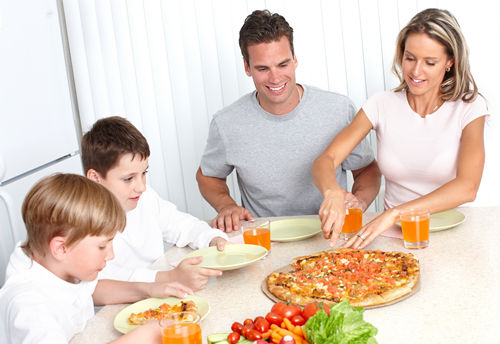HEALTHY DINNERS
 Ok, you made it. After a long and stressful day it is finally here…DINNER TIME!
Ok, you made it. After a long and stressful day it is finally here…DINNER TIME!
But what are you going to eat? Well, whatever it is you will create for tonight, eat as well and as happily as you can. Do your very best to get everyone in the house to eat together and put away their phones and games and communicate with each other while you try to get those last bites of nutrition into them before the kitchen is closed until bedtime snack time. And turn off the TV!
Do you know why it’s such a great idea for the family to eat together? There are so many reasons that your head will spin!
If you eat together, every member of the family is likely to have a lower BMI. That’s the measure of obesity (it stands for Body Mass Index) that’s used to give you an idea of whether you’re underweight, overweight or an ideal weight for your height. It’s useful to know because if your weight increases or decreases outside of the ideal range, your health risks may increase. In a society where it seems as if so many of us are getting chunkier, it’s a good thing to know about. (There are online calculators to help you figure this out. It’s easy…just put BMI into your search engine and stand back!)
Why would your BMI be lower? While no one has precisely pinpointed the reason yet, there are studies that indicate talking with your family and friends while eating tends to make you eat less. It also offers adults supervision on exactly who is eating what. Without TV and other distractions no one is eating mindlessly. And when parents eat well, their kids can see it. And when you eat (mouth closed, please!) and talk, you’ll eat less. When we talk about eating together, we’re not talking about driving around town and stopping at every fast food place and tossing bags of donuts and greasy food at each other.
That’s not healthy (you knew that!) and it doesn’t lay a good foundation for anything remotely civilized or supportive. It also doesn’t count if you bring home that same fast food and everyone grabs a plate and runs off alone to do something other than eat together. Once in a blue moon is okay, but try your best to avoid it
 If you’ve spent some time planning dinner, you know what’s supposed to be on that plate. Kids who eat with their families tend to eat more vegetables and fiber and fruit. They’ll drink milk instead of keeping an eye on the soda machine. If you don’t serve junk, they can’t eat it. Restaurant foods – just about all restaurants – offer food that tends to be saltier and fattier and higher in calories than what you’d make. And if you cook at home, the kids can help. That “saltier and fattier” is true for a lot of prepared foods, too. But we’re not about to take away all of your conveniences.
If you’ve spent some time planning dinner, you know what’s supposed to be on that plate. Kids who eat with their families tend to eat more vegetables and fiber and fruit. They’ll drink milk instead of keeping an eye on the soda machine. If you don’t serve junk, they can’t eat it. Restaurant foods – just about all restaurants – offer food that tends to be saltier and fattier and higher in calories than what you’d make. And if you cook at home, the kids can help. That “saltier and fattier” is true for a lot of prepared foods, too. But we’re not about to take away all of your conveniences.
Just read the labels! Please.
When you eat together as a family you’re strengthening your family bonds. It’s a perfect chance for everyone to catch up. Even older children and teenagers appreciate the time together. There are many studies that show that when families eat together the children learn more about their cultural heritages and their family history. It makes them closer to each other and increases their self-esteem.
This is also a great opportunity to teach a little bit of etiquette. Elbows off the table, mouth closed when you chew, don’t talk over someone else, napkin (or paper towel) in your lap. Don’t eat until everyone else is served, don’t stab your brother with a fork if he reaches for the last roll. Don’t even go for the last of anything until you ask if anyone else would like it. If you spill, clean it up, if you drop, pick it up. Ask if you may be excused when the meal is over and it’s not your turn to help clean the kitchen.
Keep your sense of humor! While everyone is loading up on healthy food and manners and self-esteem, the most wonderful thing in the world is having a good time. Laugh until the milk spurts out of your nose and you’re laughing so hard that you’re crying. Celebrate someone’s good news. Commiserate with someone’s not-so-good news. Stay close. Give everyone that comfy place to land at the end of the day. Give everyone happy memories.
Don’t ever make the dinner table a place where someone is so nervous or upset that her stomach is in knots. Nervousness is catching. It should be a safe place. You’ll have plenty of other opportunities to talk about things that might not be so pleasant. And eat slowly. Unwind. Get to know and appreciate each other. This shouldn’t be a reality show called
“The Dinner Wars”.
Okay, you have the ground rules. Now: what to make? There is not ONE food on the planet that isn’t good for dinner. Excepting Twinkies and chocolate wrapped in bacon and well, you get the picture. You can have chicken or steak or pizza or quesadillas or meatloaf or omelets or stew or salads…see? Anything can be dinner. Food you just bought, food you have frozen, last night’s dinner re-worked or just re-heated. As long as the nutrients are there, it’s dinner!
 For some strange reason – when you consider all of the information available now – Americans are eating worse now than they have in previous years. According to the Gallup-Healthways poll, healthful eating is at its lowest since 2008. Dollar menus are enticing, parents with two jobs or no jobs, lack of time, lack of planning…everything factors in. While any or all of these things might be a challenge for you, it’s more than worth it to see if you can overcome them.
For some strange reason – when you consider all of the information available now – Americans are eating worse now than they have in previous years. According to the Gallup-Healthways poll, healthful eating is at its lowest since 2008. Dollar menus are enticing, parents with two jobs or no jobs, lack of time, lack of planning…everything factors in. While any or all of these things might be a challenge for you, it’s more than worth it to see if you can overcome them.
We’re not talking about putting on Thanksgiving every night. We’re talking about protein and some fruits and vegetables and filling in the gaps of what might not have been consumed during the day. Clip coupons, shop sales, share with someone else or another family on good buys at big box stores. This might be really hard, but make it an adventure! And enjoy the spoils when your family eats well. And at how much money you saved.
Even though you know that anything is dinner, there are some tips that you want to keep in mind when cooking.
1. Don’t add sugar to anything. It contains almost no nutrients and is a pure (simple) carbohydrate. It will send your mood and blood sugar up and down and you might even have problems falling asleep.
2. Dairy fat can be sneaky. Ice cream, whole milk and cheese have saturated fat and some trans fat. You’d rather use non-fat or low-fat milk and reduced-fat cheese.
3. Don’t cook with butter when you can use olive oil!
4. Use whole-grain flours and pastas instead of white flour. They’re just as good and you and your family might even like them better.
5. Hot dogs and bacon can be delicious. So can ham and other lunch meats. But you’ll be doing everyone a favor it you use fish and skinless chicken and nuts and beans as much as you can. Save the others for once-in-a-while treats. (You know what? Don’t even call them “treats”. Just serve them when the clamor gets too loud.)
6. Keep an eye on the salt! Your body needs salt, but too much can increase blood pressure and the risk of heart disease and stroke. Try other seasonings. TIP: Have lots of fresh herbs in your child’s own herb garden. Let them harvest the herbs they like and add them to the meal. Your kids will be proud to contribute something from their own garden.
 Most people like something sweet to end a dinner with. This is an easy one! Low-fat yogurt with a topping, sherbet, ice bars or pops, fruit, healthy cookies, carrot cake, a bite of anything. A chocolate kiss! Just make sure that no one eats too much. And please don’t say: “if you don’t finish your dinner there’s no dessert”. It puts too much emphasis on dessert and takes away from the rest of the meal. The best part of this meal is that you’re having it together. Whether it’s two of you, or ten. Sometimes you might even have some unexpected guests! Enjoy.
Most people like something sweet to end a dinner with. This is an easy one! Low-fat yogurt with a topping, sherbet, ice bars or pops, fruit, healthy cookies, carrot cake, a bite of anything. A chocolate kiss! Just make sure that no one eats too much. And please don’t say: “if you don’t finish your dinner there’s no dessert”. It puts too much emphasis on dessert and takes away from the rest of the meal. The best part of this meal is that you’re having it together. Whether it’s two of you, or ten. Sometimes you might even have some unexpected guests! Enjoy.
Written by Holly White for WILLY’S KITCHEN






